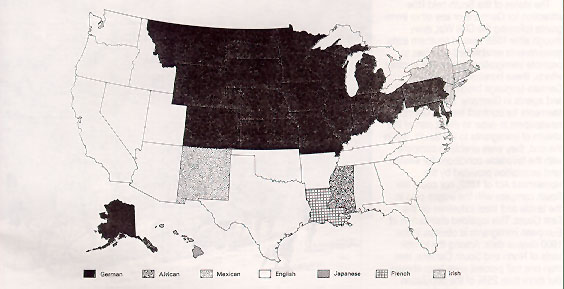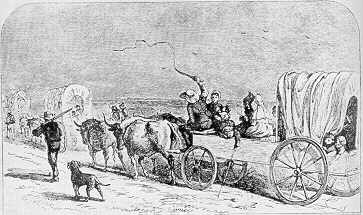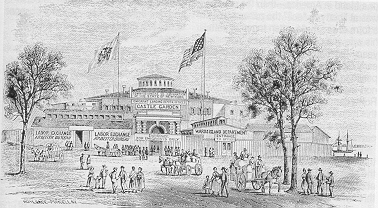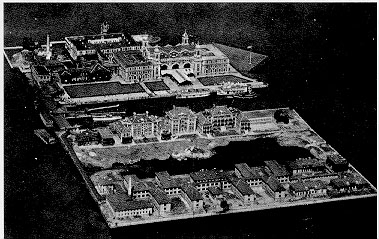




The degree to which Germans dispersed across the entire country and the
speed with which
their ethnic group was integrated into the English-speaking American
middle class could, of
course, not have been anticipated by their contemporaries. Like other
immigrant groups, the
Germans followed the natural instinct of forming neighborhoods with their
countrymen where
they felt at home far away from home. They preferred to head for a region
where they could still
acquire reasonably priced farm land in areas where German-language
churches and perhaps
German schools already existed. Thus, the path taken by an individual
often turned out to be but a
link in a growing chain that bound the Old Homeland to the new target
region. Scholars address
this as "chain migration" and cite, for example, the fact that many
Hannoverians, Oldenburgers,
and Braunschweigers traveled by way of Bremen and New Orleans to Ohio and
Missouri. Most of
the Mecklenburgers journeyed by way of Hamburg and New York and then by
railroad and ship
across the Great Lakes to Chicago and Milwaukee. This resulted in our
thinking of Milwaukee as
the "Mecklenburg capital" of the United States. Micro-studies show that
emigrants from the same
village tended to follow each other to neighboring townships and counties
in the New World
[Kamphoefner, The Westfalians, 77].

[National Origins of U.S. population by states with largest
concentrations, 1983. (Source: U.S. Dept. of Commerce, Bureau of the
Census, 1980 census Population. Supplementary Report PC 80-SI10:
ancestry of Population by State: 1980 (Washington, D.C.: Government
Printing Office,1983).]
 The dream of establishing a German dominated belt, or perhaps an
exclusively German state
in the new Union, was never realized in spite of several attempts at
large-group occupancy, such
as the settlement of over 7,000 Germans by the Adelsverein of Mainz in
Texas during the 1840s.
As a rule, the choice of a destination by the newcomers was greatly
influenced by the time frame
of their arrival. That is, there were differing phases of colonization in
the West, as well as stages
of industrialization and urbanization in the East. In the course of the
19th century, the vast
majority of Germans settled in a quadrangle encompassing the states from
Ohio to Missouri on
the south quadrant, and from Michigan to North Dakota and down to
Nebraska on the north and
west quadrants. These territories were accessible on waterways from New
Orleans up the
Mississippi and the Ohio, or the Missouri, or from New York across the
Erie Canal and the Great
Lakes, and out to areas already connected by railroads. For craftsmen,
the booming cities of
Pittsburgh, Cincinnati, Indianapolis, Louisville, St. Louis and Chicago
offered job opportunities,
which could be said also for East Coast cities like New York,
Philadelphia and Baltimore.
The dream of establishing a German dominated belt, or perhaps an
exclusively German state
in the new Union, was never realized in spite of several attempts at
large-group occupancy, such
as the settlement of over 7,000 Germans by the Adelsverein of Mainz in
Texas during the 1840s.
As a rule, the choice of a destination by the newcomers was greatly
influenced by the time frame
of their arrival. That is, there were differing phases of colonization in
the West, as well as stages
of industrialization and urbanization in the East. In the course of the
19th century, the vast
majority of Germans settled in a quadrangle encompassing the states from
Ohio to Missouri on
the south quadrant, and from Michigan to North Dakota and down to
Nebraska on the north and
west quadrants. These territories were accessible on waterways from New
Orleans up the
Mississippi and the Ohio, or the Missouri, or from New York across the
Erie Canal and the Great
Lakes, and out to areas already connected by railroads. For craftsmen,
the booming cities of
Pittsburgh, Cincinnati, Indianapolis, Louisville, St. Louis and Chicago
offered job opportunities,
which could be said also for East Coast cities like New York,
Philadelphia and Baltimore.

Between 1850 and 1920, more than 30% of all German immigrants and their
children were living in the Mid-Atlantic states. During the same period,
the percentage for the
Midwest hovered between 35 and 39%. Just as inland migration within
Europe turned at times
into overseas emigration, so too in America the stream of immigrants
followed in part the
pathways of westward migrations, moving perhaps from Pennsylvania to Ohio
and Indiana, or
maybe on a route up the Hudson, westward by way of Albany and Buffalo and
thence across the Great Lakes to Cleveland and Detroit, Milwaukee and
Chicago. These
transportation patterns resulted in the principal German settlement
region -- both rural and
urban -- mentioned above. At least a third of Wisconsin's population in
1900 was either
German-born or had at least one parent who was born in Germany; in both
Minnesota and Illinois
it was more than a fifth of the population.

The states of the South held little attraction for Germans or any other immigrants following the Civil War, even though after 1865 several southern state governments established agencies to promote immigration. In addition to other efforts, these bureaus made use of German-language brochures, placards and agents in Germany. They put advertisements for contract labor in German newspapers in order to direct part of the stream of immigrants to the South. But in the end, they were unable to compete with the favorable conditions for western land acquisition provided by the Homestead Act of 1862, nor could the South compete with the wages paid in the textile and steel industries on the East Coast. This lopsided distribution of European immigrants is obvious in the 1900 census data. Among the inhabitants of North and South Carolina, less than one half percent were born abroad. But more than 25% of the population had been born abroad in the states of New York, Rhode Island, Connecticut, Massachusetts, Wisconsin, Montana and Minnesota; North Dakota outdistanced all others with 35.4% born abroad. The unequal distribution of the Germans across the nine major regions of the United States from the New England states to the Pacific can easily be observed in the following table.
| Table 4. Distribution of German-born, 1850-1960 (In percent) | ||||
|---|---|---|---|---|
| Region | 1850 | 1860 | 1920 | 1960 |
| New England | 1.2 | 1.8 | 3.0 | 3.9 |
| Middle Atlantic | 36.0 | 30.0 | 30.1 | 38.5 |
| East North-Central | 39.1 | 39.8 | 35.1 | 25.3 |
| West North-Central | 9.0 | 16.6 | 17.4 | 7.1 |
| South Atlantic | 6.6 | 3.6 | 2.4 | 5.8 |
| East South-Central | 3.0 | 2.0 | 1.0 | 0.9 |
| West South-Central | 4.6 | 2.9 | 2.8 | 2.2 |
| Mountain | -.- | 0.8 | 2.0 | 2.9 |
| Pacific | 0.6 | 2.5 | 6.1 | 13.2 |
[Source: Cathleen Conzen, "Germans," (1980), 412.]


